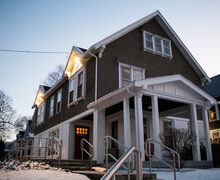Year In Sports: Syracuse teams struggle with athletic facility limitations
Last February, Syracuse University Athletics announced plans for a new, state-of-the-art $17 million practice facility for the Orange’s football program.
The proposed facility, to be built where the Joseph Vielbig Outdoor Track Stadium stands now, is expected to vastly enhance the program’s status and attract better recruits. Along with plans to build a new track facility on South Campus, it will also benefit other teams in the athletic program.
Until these new facilities open, though, some Syracuse programs have had to and will continue to compromise their practices due to the state of SU’s current facilities.
Even when the facilities are constructed, some programs will remain unimproved.
“Everyone has their own quirky things that maybe they’re working on,” said Paul Flanagan, the Syracuse women’s ice hockey head coach, “and their own little battles they have to fight.”
Women’s lacrosse combats overcrowding
When plans for the new football facility were announced, the SU women’s lacrosse program was fresh off a 2012 national championship appearance.
Some players had to — and still do — share lockers with each other in the team’s locker room at Manley Field House.
“I think it’s kind of b.s., personally,” Becca Block, a former SU defender, said last year, “because if you look at our locker room, definitely, I think it’s the worst one in Manley.”
The new football practice field will benefit both lacrosse teams, but won’t address the women’s team’s undersized locker room. So Gary Gait’s team took it upon itself to make a change.
As of April 16, the team had just over $100,000 left to raise to reach its goal of $1.2 million for a new locker room, Gait, SU’s head coach, said.
“If you want something done, sometimes you got to get involved and raise money yourself,” Gait said.
The Orange’s fundraising has relied mostly on parents, alumni and friends of the program.
But when asked if SU Athletics has helped out the team’s effort financially, Gait didn’t answer directly.
“Uh,” Gait said, dragging it out with a laugh. “We’re continuing to raise money. We’ll keep working on it.”
Gait said he hopes construction will begin in May and finish this summer. Though Gait said the location of the new locker room is being narrowed down, senior attack Alyssa Murray mentioned that a current Manley weight room could be remodeled into the new locker room.
“We’re due for a new locker room. Let’s just say that,” Gait said with a smile. “Certainly our plans for our facility will make it the best in the country.”
Murray said she doesn’t feel slighted that the team has had to take action itself without financial assistance from SU, but she and her teammates still feel they deserve better than what they have.
“The major thing is you want everyone to have their own space and have a space where you can hang out as a team,” Murray said. “I’m sure there are teams that have it worse than we do, but we’re a top team and we want to be able to celebrate that with a nice locker room.”
Men’s lacrosse adjusts to short practice field
When the SU men’s lacrosse team took the field in the Carrier Dome for its home opener Feb. 10, it was one of the first times the Orange played on a full field.
“We had almost nothing,” SU head coach John Desko said. “The cost of changing the Dome over from basketball to a full field for lacrosse is a lot. There just weren’t enough days to justify doing that.”
Desko often referenced Manley Field House’s 80-yard practice field when discussing his team’s early-season problems.
With basketball season overlapping with lacrosse and snow layering SU’s outdoor practice field, there was no full field for Desko’s squad to use. Gait said the women’s team faced the same issue.
“It’s getting old,” Desko said on March 3. “It’s hard to go against southern teams that have been on a full field the whole time.”
Nearly every position group had to adjust to practicing at Manley, which, in addition to not being as long as a full lacrosse field, isn’t as wide.
Syracuse’s clearing especially took a hit — an aspect of the game the Orange couldn’t afford to struggle in with its early-season problems at the faceoff X. The team’s clearing percentage still ranks outside the country’s top 35.
Said Desko of the new football practice facility: “That can’t get built quick enough for us.”
Field hockey practices in Archbold Gymnasium
Field turf isn’t an option for Ange Bradley’s field hockey team to practice on, so the hardwood of Archbold Gymnasium is SU’s winter home.
“Ideally, I’d like to have an indoor turf like Colgate has or the schools in the Big Ten have,” Bradley said. “But we’re not those schools and we don’t have that. What we do have is a wood floor that we practice on and use for skills and play indoor hockey.”
When the Syracuse winter hits, covering J.S. Coyne Stadium’s Astro 12 surface in snow, Bradley has little choice but to bring her team up to main campus and use a campus-wide facility.
SU doesn’t have an indoor AstroTurf facility for the field hockey program, the new indoor football facility won’t benefit field hockey and Bradley said practicing on the Manley turf would do the team more harm than good.
“Archbold is a very good training facility for us,” Bradley said. “The fact that we can use Archbold and train on a fast surface, it’s good. Is it the best? No. But it’s better than field turf.”
In the past, the Orange has started using Coyne right after Spring Break. This winter, though, the team couldn’t practice on its home field for two weeks after break.
As the temperatures rise and SU begins its early season play, the switch from indoor practices to outdoor play results in an adjustment period, Bradley said. Different sticks are used, and running is different.
“It’d be nice to be on a surface playing,” Bradley said. “But we’re able to maintain our competitiveness. We have to work a little bit harder than other programs out there, but hard work doesn’t hurt anyone, I guess.”
Ice hockey looks to ‘raise its profile’
Visitors to Tennity Ice Pavilion, unimpressed, ask Flanagan if the venue is his practice facility.
“Yeah, it is,” he tells them. “And we play our games here, too.”
It’s an ongoing battle for him and the women’s ice hockey program. The Department of Recreation Services owns Tennity Ice Pavilion. Flanagan said the building holds the program back in recruiting. He said the team feels fortunate to have a venue on campus, but has to compensate for Tennity in recruiting.
Making it a more spectator-friendly venue — an aspect recreation services isn’t concerned with, Flanagan said — is where he would start improvements.
At 45 degrees Fahrenheit, it isn’t a comfortable environment for spectators, he said. Added seating would help separate the hockey rink from the studio rink — where recreation services allows people to skate during games.
Those people can be seen on camera during broadcasts of the Orange’s games, also embarrassing Flanagan, he said, when he exchanges video with opposing teams.
In the past year, the Orange installed a new carpet placed in its locker room at Tennity and now has a 70-inch smart TV.
With the rest of the money the program has in its operating budget and from donors, it’s been able to keep its weight room at Tennity well-maintained.
“It’s a fully stocked, fully equipped operation there,” Flanagan said. “We have everything we need. Our locker room’s beautiful, but we kind of went rags to riches.”
The rest of Tennity is the problem.
“Sometimes I feel like I’m fighting city hall,” he said. “But I think we should try to take pride in our facilities as a university. It shouldn’t matter if it’s athletics’ money, rec services’ money.”
SU played three games at the War Memorial Center this season to combat Tennity’s issues. The Orange can schedule almost any weekday game it wants there, Flanagan said.
“If we didn’t have this rink on campus, it’d be a nightmare for us,” Flanagan said of Tennity. “But I really think we should try to make that facility something we’re a little bit more proud of.”
Published on April 28, 2014 at 12:36 am
Contact Phil: pmdabbra@syr.edu | @PhilDAbb





